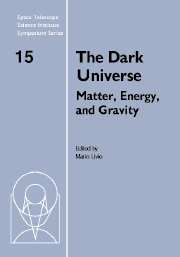Book contents
- Frontmatter
- Contents
- Participants
- Preface
- A brief history of dark matter
- Microlensing towards the Magellanic Clouds: Nature of the lenses and implications on dark matter
- Searching for the Galactic dark matter
- Hot gas in clusters of galaxies and ΩM
- Tracking the baryon density from the Big Bang to the present
- Modified Newtonian Dynamics and its implications
- Cosmological parameters and quintessence from radio galaxies
- The mass density of the Universe
- Growth of structure in the Universe
- Cosmological implications of the most distant supernova (known)
- Dynamical probes of the Halo Mass Function
- Detection of gravitational waves from inflation
- Cosmological constant problems and their solutions
- Dark matter and dark energy: A physicist's perspective
Modified Newtonian Dynamics and its implications
Published online by Cambridge University Press: 21 August 2009
- Frontmatter
- Contents
- Participants
- Preface
- A brief history of dark matter
- Microlensing towards the Magellanic Clouds: Nature of the lenses and implications on dark matter
- Searching for the Galactic dark matter
- Hot gas in clusters of galaxies and ΩM
- Tracking the baryon density from the Big Bang to the present
- Modified Newtonian Dynamics and its implications
- Cosmological parameters and quintessence from radio galaxies
- The mass density of the Universe
- Growth of structure in the Universe
- Cosmological implications of the most distant supernova (known)
- Dynamical probes of the Halo Mass Function
- Detection of gravitational waves from inflation
- Cosmological constant problems and their solutions
- Dark matter and dark energy: A physicist's perspective
Summary
Milgrom has proposed that the appearance of discrepancies between the Newtonian dynamical mass and the directly observable mass in astronomical systems could be due to a breakdown of Newtonian dynamics in the limit of low accelerations rather than the presence of unseen matter. Milgrom's hypothesis, modified Newtonian dynamics or MOND, has been remarkably successful in explaining systematic properties of spiral and elliptical galaxies and predicting in detail the observed rotation curves of spiral galaxies with only one additional parameter—a critical acceleration which is on the order of the cosmologically interesting value of CH〪. Here I review the empirical successes of this idea and discuss its possible extention to cosmology and structure formation.
Introduction
Modified Newtonian dynamics (MOND) is an ad hoc modification of Newton's law of gravity or inertia proposed by Milgrom (1983) as an alternative to cosmic dark matter. The motivation for this and other such proposals is obvious: So long as the only evidence for dark matter is its global gravitational effect, then its presumed exitance is not independent of the assumed form of the law of gravity or inertia on astronomical scales. In other words, either the universe contains large quantities of unseen matter, or gravity (or the response of particles to gravity) is not generally the same as it appears to be in the solar system.
- Type
- Chapter
- Information
- The Dark UniverseMatter, Energy and Gravity, pp. 62 - 76Publisher: Cambridge University PressPrint publication year: 2004



